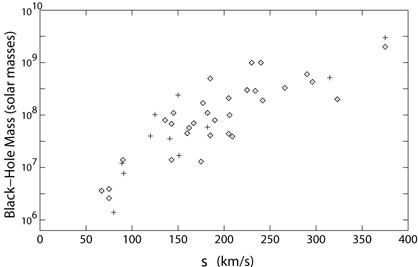


In general, galaxies consist of two main visible components - a central ellipsoidal bulge and a flat disc structure commonly containing spiral arms - together making a structure resembling two fried eggs back-to-back. Elliptical galaxies have no discs and are dominated by their bulges, maintaining their shapes by the random motions of their stars; spiral galaxies, like our own Galaxy and nearby Andromeda have prominent discs and are supported mainly by rotation, with rotation speeds between 200 km s-1 and 300 km s-1. Some spiral galaxies contain a bar-like structure that crosses the nucleus; the spiral arms then begin at the ends of the bar and wind outwards. If the bar is narrow and straight it is classed as a `strong' bar and if oval-shaped (essentially an elongated bulge) it is `weak'. Dynamical simulations have revealed that in the region of the bar, stars do not travel on circular orbits as they do in the disk, but instead follow more elongated elliptical, or `non-circular' paths.
With the great progress made recently in measuring the mass of central
supermassive black holes in a significant number of active and
non-active galaxies, correlations with their host galaxy properties
are now possible.
Maggorian et al.
(1998)
confirmed the
correlation between the brightness of a galaxy bulge (and hence
stellar mass) and the mass of its central black hole (e.g.
Kormendy & Richstone
1995)
establishing a best fit to the linear relation of
M = 0.006
Mbulge, despite a large scatter. A much
tighter correlation was subsequently discovered between the velocity
dispersion (σ) of stars in the host galaxy bulge and the
central black hole mass (e.g.
Gebhardt et al
2000;
Ferrarese & Merrit
2000).
The velocity dispersion is a measure of the range of
random speeds present in star motions and is potentially a more
reliable galaxy mass indicator than total starlight; the greater the
spread in speeds, the more massive the galaxy bulge. The tightness of the
correlation points to a connection between the formation mechanism of
the galaxy bulge and central black hole although the physics involved
are not yet known. The
M
= 0.006
Mbulge, despite a large scatter. A much
tighter correlation was subsequently discovered between the velocity
dispersion (σ) of stars in the host galaxy bulge and the
central black hole mass (e.g.
Gebhardt et al
2000;
Ferrarese & Merrit
2000).
The velocity dispersion is a measure of the range of
random speeds present in star motions and is potentially a more
reliable galaxy mass indicator than total starlight; the greater the
spread in speeds, the more massive the galaxy bulge. The tightness of the
correlation points to a connection between the formation mechanism of
the galaxy bulge and central black hole although the physics involved
are not yet known. The
M -σ
relation for a
mixture of nearby active and non-active galaxies
(Figure 5),
measured using a variety of techniques, shows the relationship between
bulge and black hole is very similar for both, although investigations
continue to establish the precise form of the correlation and whether
it is universal for active and non-active galaxies. If universal, this
relationship would provide exciting confirmation that non-active
galaxies contain dormant versions of the same kind of black holes that
power AGN.
-σ
relation for a
mixture of nearby active and non-active galaxies
(Figure 5),
measured using a variety of techniques, shows the relationship between
bulge and black hole is very similar for both, although investigations
continue to establish the precise form of the correlation and whether
it is universal for active and non-active galaxies. If universal, this
relationship would provide exciting confirmation that non-active
galaxies contain dormant versions of the same kind of black holes that
power AGN.
 |
Figure 5. Black hole mass against host galaxy bulge stellar velocity dispersion for nearby AGN (open diamonds) and non-active galaxies (+ symbols) [using data from Kormendy & Gebhardt (2001) and Ferrarese et al. (2001)]. |
No correlation exists between galaxy disc properties and black hole mass, and disc galaxies without bulges do not appear to contain supermassive black holes (e.g. Gebhardt et al. 2001), suggesting discs form later and are not involved in the process that intimately links the black hole and bulge.